
The following is an entry in Tales of Praxis, a weekly series studying the storytelling and philosophy of Bandai Namco’s Tales series through written analyses and streamed playthroughs of a wide range of the Tales games on With a Terrible Fate’s Twitch channel and YouTube channel.
“Don’t try to hide it, because someone already wants to be your best friend. He lives his life punishing himself. He thinks that you may be able to heal his loneliness and regret. You two may be able to become like brothers.”
—The Triet Fortune-Teller, hinting at Regal as Lloyd’s best friend
When I wasn’t looking for him, Regal Bryant found me and taught me about penance, redemption, and growing up.
(Spoilers for Tales of Symphonia and Tales of Symphonia: Dawn of the New World.)
When I returned to Tales of Symphonia for the first time in over a decade through the release of Tales of Symphonia Remastered this year, I had intended to focus on cultivating the relationship between Lloyd and Kratos. Their story was a cornerstone of my childhood experience falling in love with video-game stories: not only did it offer a moving portrait of a complex father-son relationship, but it also taught me how the interactive stories of video games can move you by gathering together party members who develop bonds we don’t fully understand until the end of the story—not even, sometimes, until the end of multiple journeys through the story. The Kratos I came to know in my childhood evolves from a quiet stranger supporting the party, to boss and apparent traitor serving Cruxis, to the father figure he was all along for Lloyd.
The bond between Lloyd and Kratos is that special sort of JRPG magic that allows you to discover its contours through choices that aren’t overtly explained to you: there’s no guide or tutorial within Tales of Symphonia that walks you through the relationship system governing the party’s bonds with Lloyd, yet your natural choices and discovery of small, often optional moments throughout the story determine which character will become Lloyd’s closest friend and have a unique role in the game’s climax—and also makes it possible for Kratos to rejoin the party for the final confrontation against Mithos, if only Lloyd and the player prioritize that relationship enough.
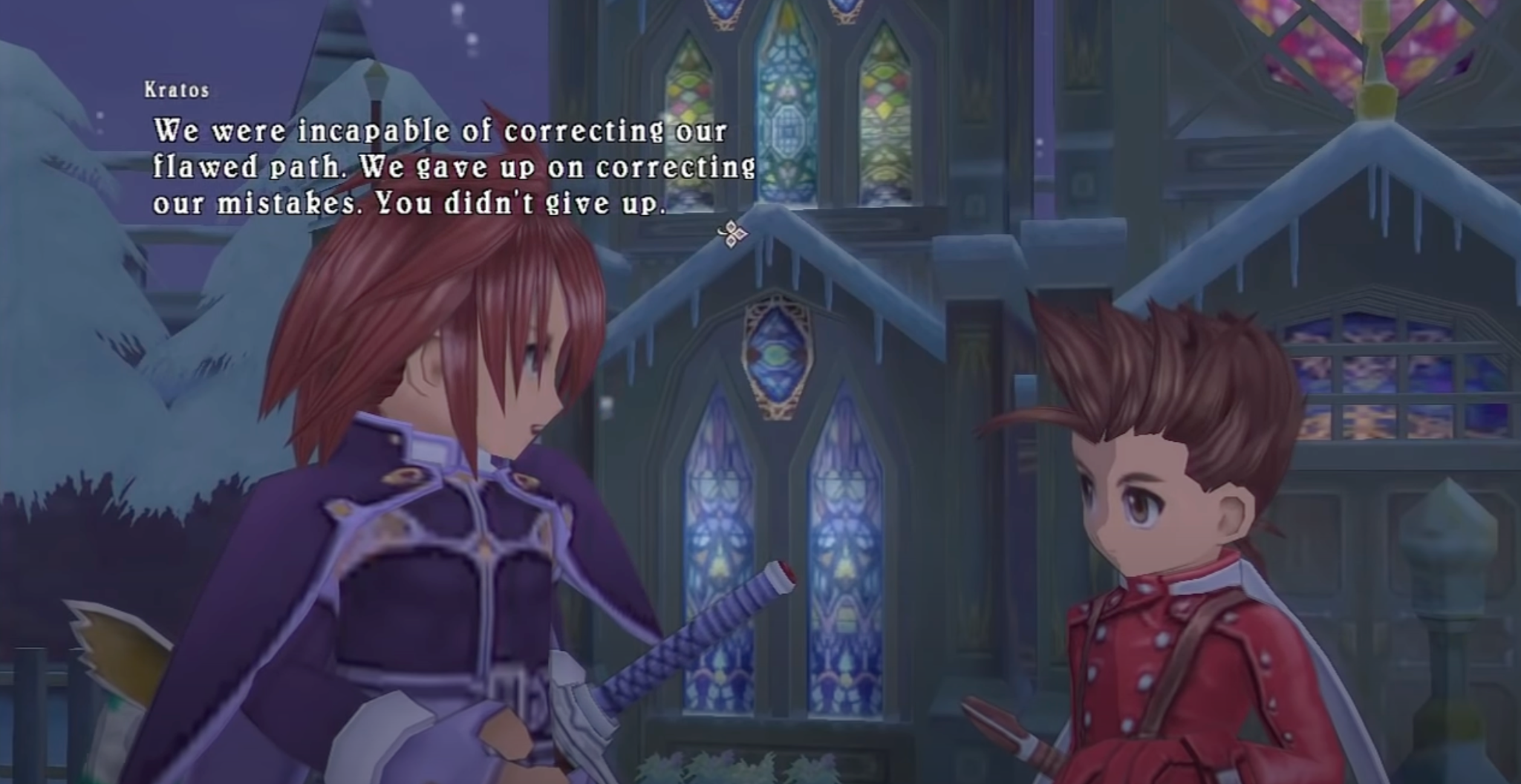
In Kratos’ intimate, optional conversation with Lloyd in Flanoir prior to the party’s assault on the Tower of Salvation, Kratos opens up to Lloyd about his past with Mithos, Martel, Yuan, and Anna.
You can imagine my surprise, then, when my playthrough of Tales of Symphonia Remastered didn’t feature Kratos after all—at least, not in the way I’d expected. As part of Tales of Praxis, I streamed that playthrough, and I had an unreasonable amount of fun teasing the story of the Lloyd/Kratos relationship, along with Kratos’ eventual return to the party, to those viewers who had never played the game before. By the time we reached Flanoir on the evening before the party raids Cruxis in an effort to save Colette from her Chronic Angelus Crystallus Inofficium, I was in a delighted frenzy: especially if you’ve never played the game before, the discovery that Lloyd has the opportunity to have a special heart-to-heart conversation with a close friend of your choice is already an unusual kind of JRPG magic—to say nothing of the revelation that Kratos can actually return and speak father-to-son with Lloyd at this moment. Confident in the experience I’d gained in the nuances of Symphonia’s relationship system from countless playthroughs of the game as a kid, I deliberately foreshadowed how amazed everyone would be, after rejecting all of the visitors to Lloyd’s room, to hear Kratos’ voice calling out to Lloyd from outside.
Small wonder, then, that I was visibly stunned when, after rejecting Colette and Genis, Lloyd found himself face-to-face with Regal: heading outside for a chat in the snow, with Kratos nowhere to be found.
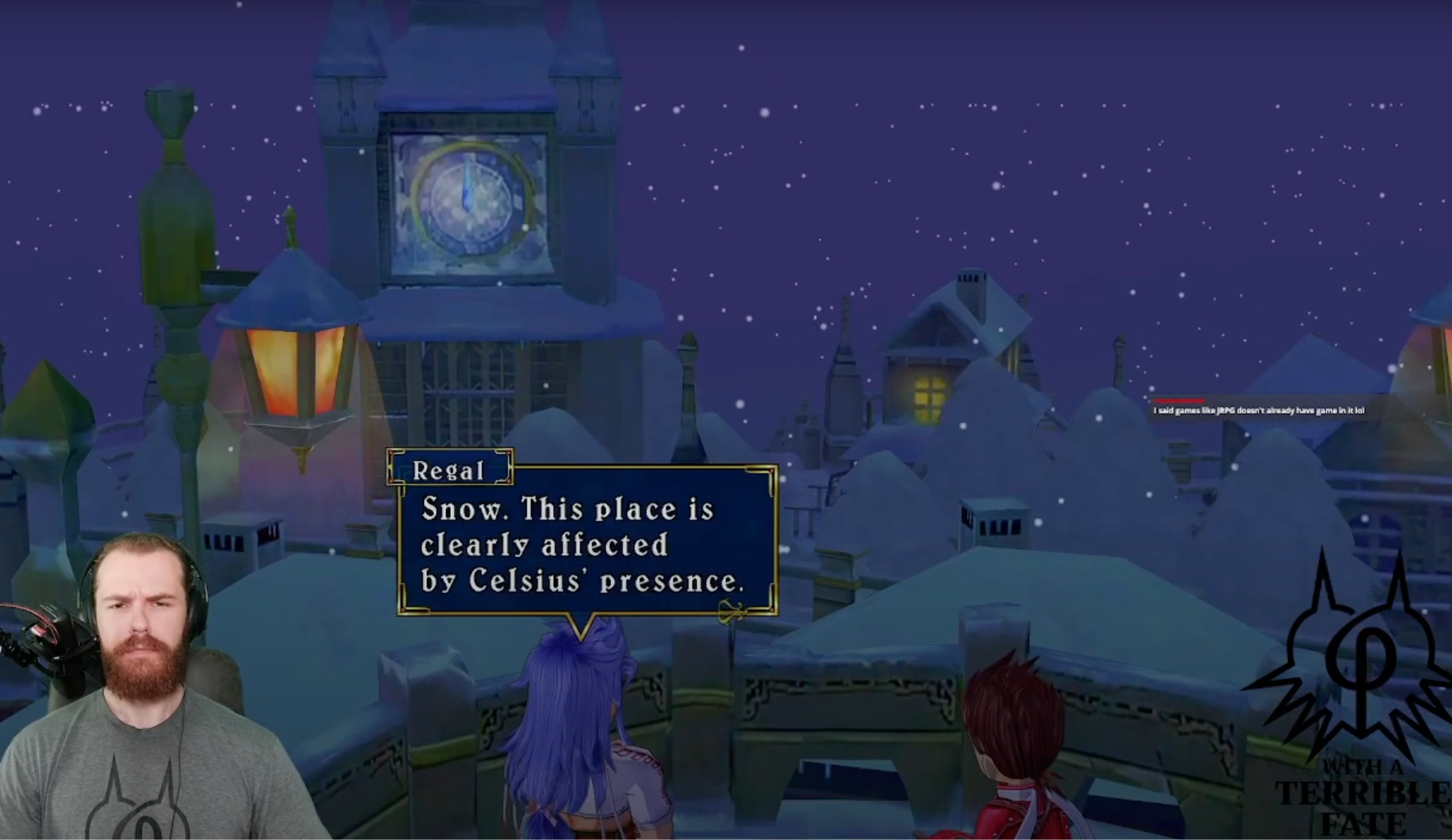
Direct quote from my trenchant, real-time commentary: “…I think I did something wrong…”
Technically speaking, what happened was this: without intending it, I’d made choices throughout the game that led to Lloyd’s affinity being highest with Colette, Genis, and Regal; if Kratos isn’t one of Lloyd’s three closest relationships at the moment when you enter the Flanoir heart-to-heart sequence, there’s no condition that will trigger Kratos’ reappearance. Thematically and personally, this wasn’t just a surprising outcome, but also a revealing moment in my relationship with the story. Colette and Genis are Lloyd’s closest childhood friends and therefore very difficult for the player to unseat from Lloyd’s inner circle; Regal, on the other hand, is the last of the nine party members to join up with Lloyd and his friends, providing proportionately less time for Lloyd—and, presumably, the player—to bond with him at all.[1] Yet following only my memory of the game and my personal inclinations, and despite intending to prioritize Kratos, the game demonstrated to me unequivocally that I’d been magnetically drawn to Regal.
How had this happened?
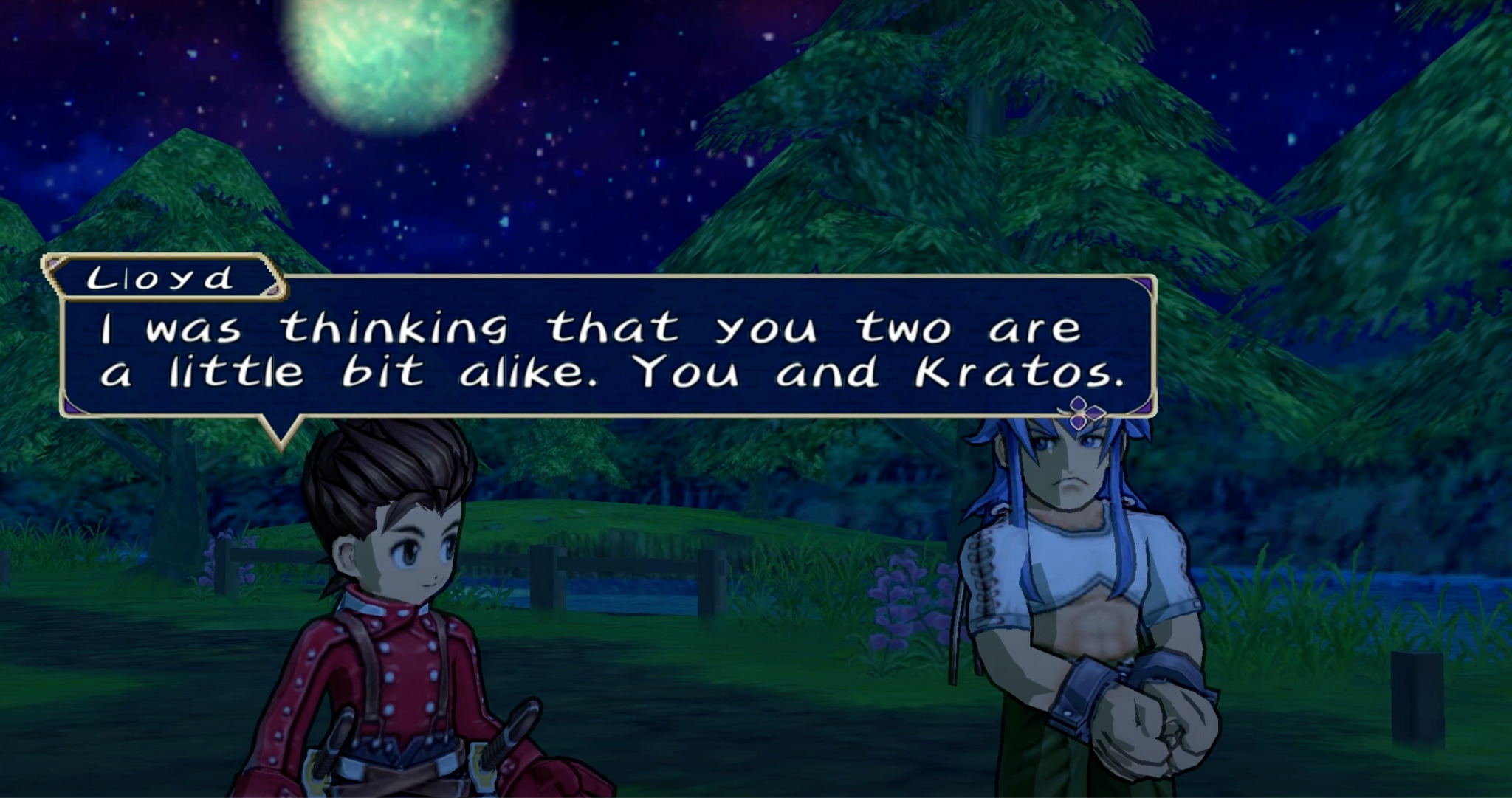
Lloyd reflects on the similarities between Regal and Kratos in a nighttime conversation with Regal the night before facing Kratos to release Origin’s seal.
When the player makes Regal and Lloyd’s relationship the strongest of Lloyd’s bonds with any other party member, the two of them end up explicitly pointing to the similarities between Regal and Kratos: both are older men within the party who have lived through previous journeys, endured personal suffering, and borne the burden of sin from their past actions. Despite Kratos being Lloyd’s biological father, Lloyd finds it more natural to think of both him and Regal as his “older brother[s]” by virtue of the journey they’ve shared together. Regal and Kratos, too, both had to kill their loved ones after Alicia and Anna became victims of the Angelus Project, and both find a kind of redemption through the journey they can share with Lloyd over the events of Tales of Symphonia.
But one of the central lessons of Tales of Symphonia is that there is a difference between intellectually grasping the relationships between people and emotionally understanding those relationships. This is the difference between (1) reading the full text describing all permutations of Lloyd’s relationships with his companions[2] and (2) playing through a range of different possible playthroughs, experiencing what it’s like not only for Lloyd to cultivate certain relationships, but also for you, the player, to bring those relationships about from unique vantage points. In that spirit, I felt like I hadn’t really understood what Regal could teach me about Kratos—nor about the ethos of Tales of Symphonia, and even the ethos of Tales of Symphonia: Dawn of the New World, more broadly—until I found myself attracted to Regal’s character as an adult—for it was only at that point that I saw clearly the vantage point from which I’d pursued Kratos as a younger gamer, and the new light in which I could interpret both him and myself as an adult.
Reading Tales of Symphonia Through the Eyes of its Party Members
When I stepped back into Tales of Symphonia as an adult through Tales of Symphonia Remastered, I realized that this new playthrough had a stark difference from the many playthroughs I’d undertaken as a child. In my younger days, I’d focused almost exclusively on Lloyd: controlling him in battle whenever I was given the option, and interpreting the story through the filter of Lloyd’s perspective: this was his journey, and everyone else was along for the ride. On the one hand, this is an understandable default since Lloyd is the character through which we get the most consistent point of view and perspective through which to access the narrative as a whole: with the exception of Sheena’s duel against Kuchinawa and some Coliseum bouts, it’s Lloyd alone on whom we can rely to always be available in our party as we navigate the three worlds of Tales of Symphonia.[3] On the other hand, in a game that is centrally concerned with the rejection of discrimination and the celebration of diverse individuals coping with singularly challenging pasts, it seems myopic (in hindsight) to prioritize Lloyd in our overall experience and understanding of the story.
Now, as I played through Tales of Symphonia Remastered at 28 years old (the same age as Presea during the story’s events), I was much more keenly attuned to those other than Lloyd, particularly those like Sheena and Regal who had already been through painful personal journeys in their past and treated the story of Tales of Symphonia as an opportunity to work through, change their perspective on, and heal from those past struggles.[4] It was only after adopting this new stance that I was able to see these other characters on their own terms—and that I recognized the difference between Kratos as I’d seen him in earlier playthroughs and Kratos as he could be seen in the light of Regal’s evolving relationship with the world and himself.
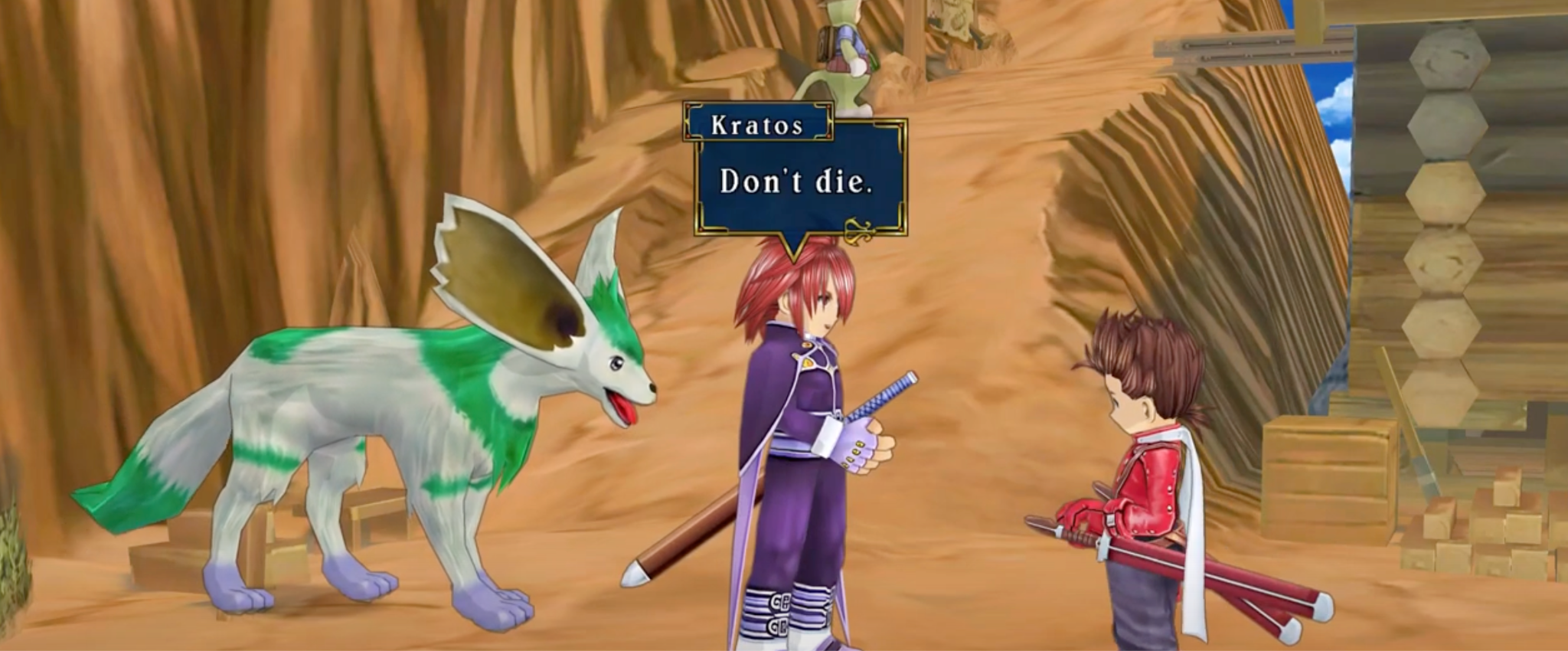
Kratos quietly and cryptically charges Lloyd to survive in Hima, ahead of Kratos’ betrayal at the Tower of Salvation.
The Kratos I saw and was drawn to in my youth was one who was mediated through Lloyd’s perspective. In intimate moments like his training sessions with Lloyd, the father-son confrontation with the Desian Grand Cardinal responsible for Anna’s tragic fate, and even Kratos’ decision to join his son in the final battle against Mithos, I saw first and foremost the opportunity for Lloyd to learn from his father: for Kratos to temper Lloyd’s inchoate yet brilliant sense of justice, and for Lloyd’s relationship with his father to inform the meaning and resolve with which Lloyd channels the spirit of his mother to germinate the Great Seed and will a new world into existence at the game’s conclusion. It was not so important to me that Kratos returned to the party for the sake of Kratos’ development as a character, but rather that he returned as a mark of validation that Lloyd’s actions—and my choices, as the player behind the wheel—merited the approbation of Kratos both as Lloyd’s father and as the wayward moral compass of Cruxis, on whose authority the world had been consigned and restricted to its current, broken yet stable state.
Finding Regal in my most recent playthrough not only gave me a new kind of appreciation for his character per se: it also gave me the interpretive tools to see Kratos as a character that finds redemption on his own terms, an interpretive exercise which also allows me, as a player, to undergo the same kind of cathartic restructuring of my beliefs and approach to understanding people that Tales of Symphonia time and again shows is a prerequisite for making any progress in the world.
How Regal Empowers Himself by Reinterpreting His Sins
In Regal we find a portrait of someone who has not merely had a painful personal journey in his own past, but who has also cruelly, pitifully subjected himself to the same fate which other characters suffered at the hands of third-party oppressors. In order to cope with his guilt over killing Alicia, Regal objectifies himself: he surrenders himself to the authorities and sees his hands bound as “a symbol of [his] crime, as well as [his] punishment,” and he recasts himself, mechanically and narratively, as an enemy of Sylvarant’s Chosen One in the hope of buying the Pope’s cooperation in arresting Vharley, the Exsphere broker responsible for turning Alicia into a monster through the Angelus Project.
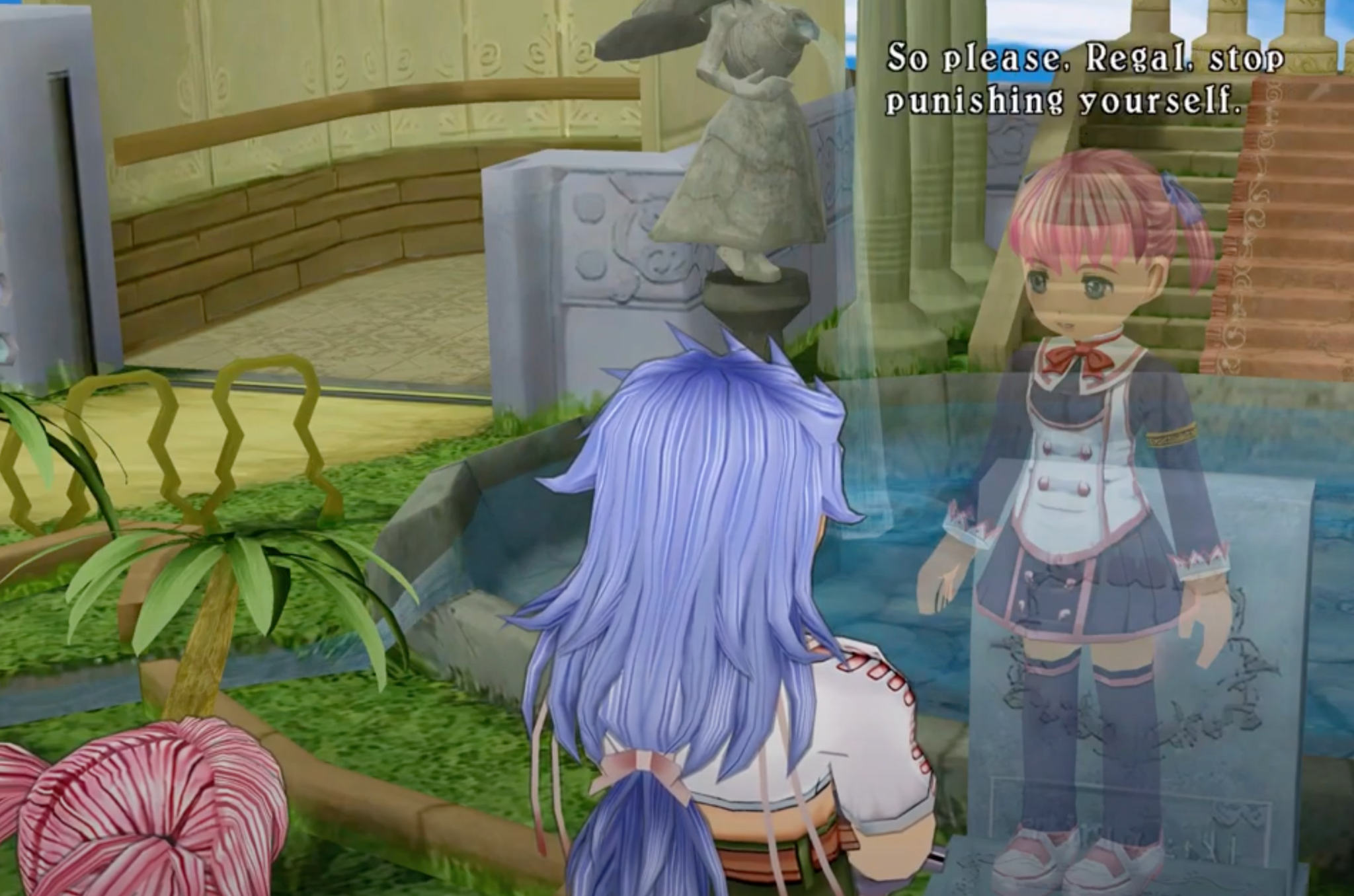
Alicia begs Regal to stop punishing himself for killing her, before she disappears from the world completely.
In effect, Regal turns himself into an instrument no different from an Exsphere like Alicia, Marble, or Anna, reduced from the autonomy and intrinsic value of a person to the utility of a piece of equipment. In his own words, Regal “lost the will to atone for [his] crimes by taking comfort in the feeling of being punished,” finding comfort in a suspended state similar to what Mithos describes in one of his three psychological traps in Welgaia: “you will neither live nor die. You will be trapped in the true darkness, tormented in isolation forever.”
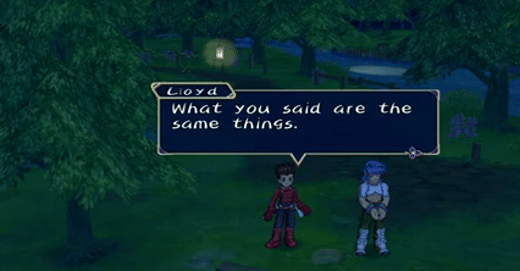
In Heimdall, Lloyd suggests to Regal that Regal’s pursuit of revenge comes to the same thing whether he sees it as being motivated by a duty to Alicia or by his sadness at having lost her.
Ultimately, Regal is able to free himself from the prison of his self-condemnation by reinterpreting the meaning of his actions: not rejecting his past, like the Pope, nor enslaving himself to his past, like Mithos, but telling a new story about his actions that allows him to participate in a new, more productive and autonomous future. By connecting with the source of his guilt, Alicia, in a new context shared with Presea, who’s similarly been trapped in time by the loss of her sister, and his friends who have experienced similar episodes of suffering, like Lloyd and Genis with Marble, Regal is able to fashion a new symbol out of his penance and thereby chart a new course in his life: the shackles that were once a symbol for Regal’s self-denial become a symbol for his resolve to create a world in which no person will be used in the way he, Alicia, or his friends were used.
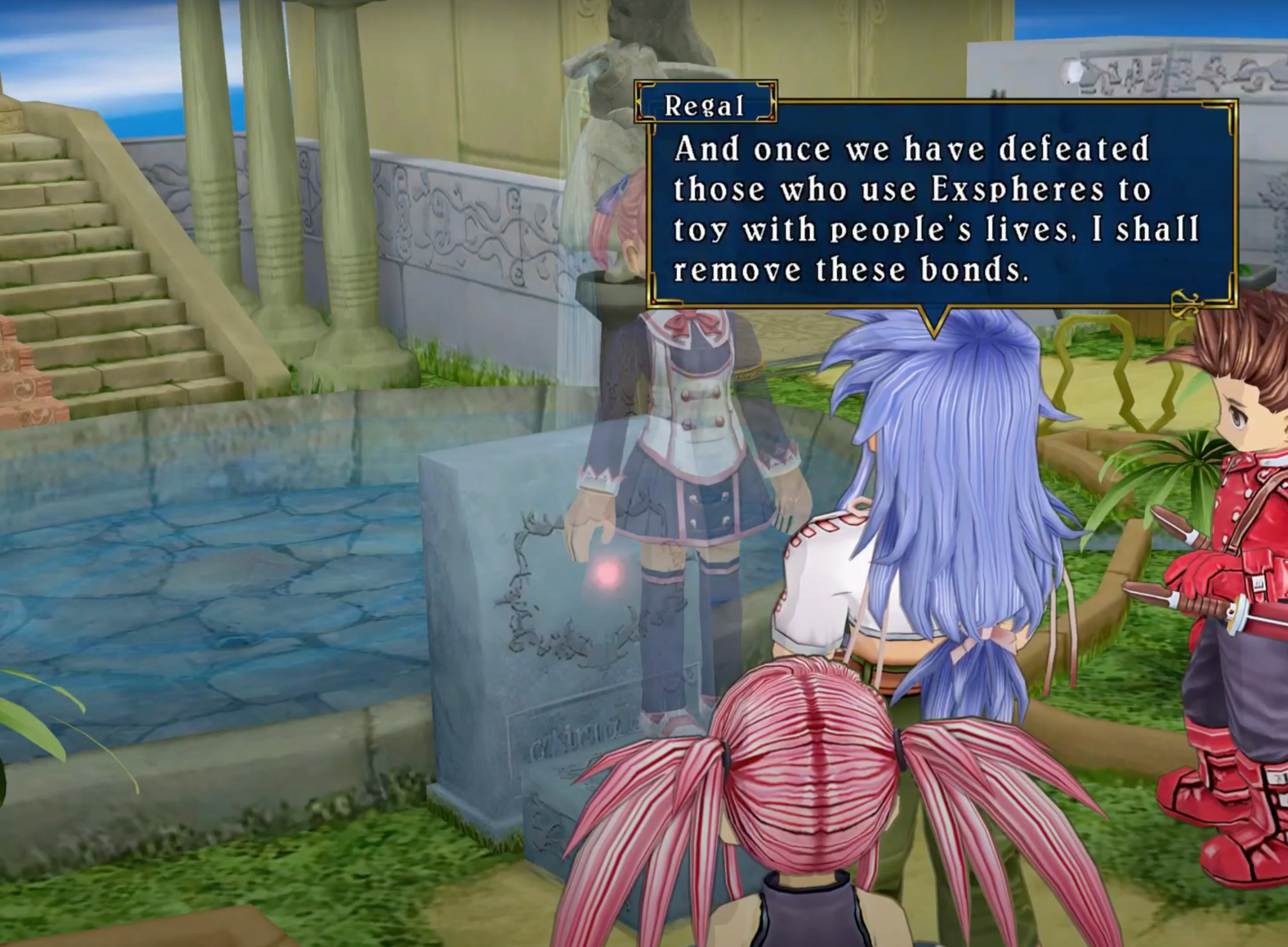
Regal reconfigures his shackles from a symbol of punishment into a symbol of resolve before Alicia, the object of his love and sin.
Together, Regal and Presea are able to heal from Alicia’s death in the way that’s unavailable to Mithos in the case of Martel: they’re able to relate to each other, as the biological and chosen family of the victim, and recognize, through the medium of a mutual conversation with that victim, that their anguish has more to do with their own inner life than with the victim per se. Whereas Mithos retreated into the self-righteousness of his plan to restore his sister exactly because he felt as though their bond as half-elves isolated them from the rest of society, Regal and Presea, united over Alicia’s grave by the providence of Lloyd’s party and their joint interests in a united world, are able to recognize that it does equal justice to their relationship to the victim, while being more conducive to a positive relationship between the survivors and the world, to treat their shared loss as a motivation to create a different kind of world, rather than as reason to protect their wounded egos by persecuting each other. It’s telling in this regard that Regal and Presea, on playthroughs in which neither has the closest relationship with Lloyd of all available party members, find themselves in a literal and symbolic prison cell together, equally bound to a prison of punishment misconstrued as justice:
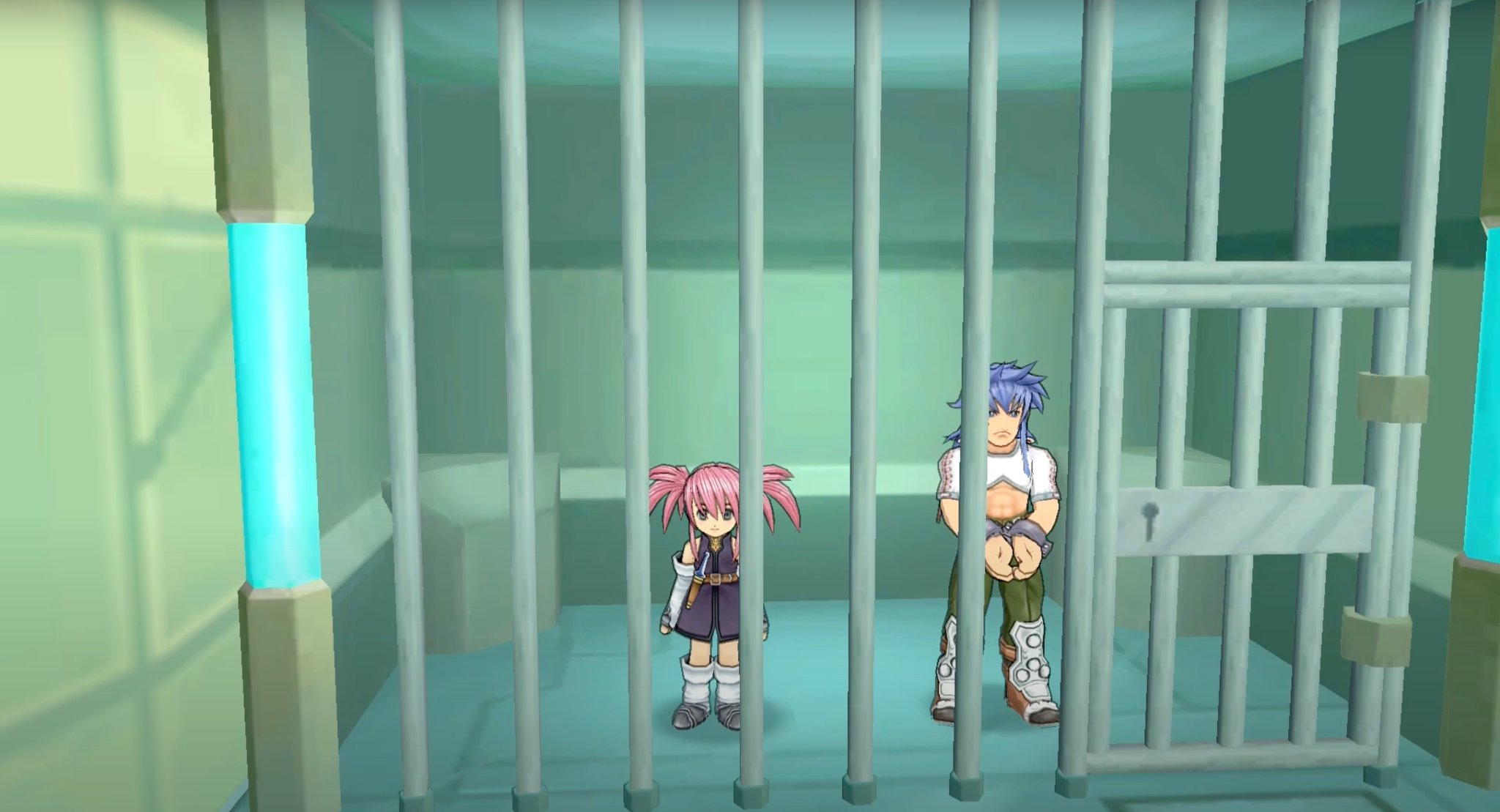
Regal and Presea face imprisonment in one of Mithos’ psychological tortures in Welgaia.
Lloyd routinely bolsters Regal and Presea with a sympathetic perspective that empowers them to reconfigure their relationship with Alicia’s death, the concept of punishment, and each other. Lloyd has the standing to share his experience with the Desians transforming Marble and scapegoating him and Genis as the objects of Chocolat’s hatred, as well as his imagined perspective of what it must have been like for his father to kill his transformed mother (before he knows their identities as Kratos and Anna). Mithos interprets the criticism of everyone, including Martel, through a sophistic lens justifying the moral force of his original actions: Martel’s expression of regret that “If things were going to end up like this, perhaps the elves should never have left Derris-Kharlan” is heard by him as a coded message that she “just wanted to leave this filthy world and return to Derris-Kharlan”; his mentor’s attempt to correct him, in the event that Kratos rejoins the party, is coded as a “betray[al]” of his mission and ideals. Regal and Presea, in contrast, are able to see themselves as two complementary halves of a system of suffering brought about by an inequitable world in which people use each other as tools: Presea the victim whose development has been literally and figuratively suspended by the same system that turned her sister into a pawn and cost her her life, and Regal the victim who had to sin and do violence to a loved one in order to honor that loved one’s wishes and bring about the best of all available outcomes.
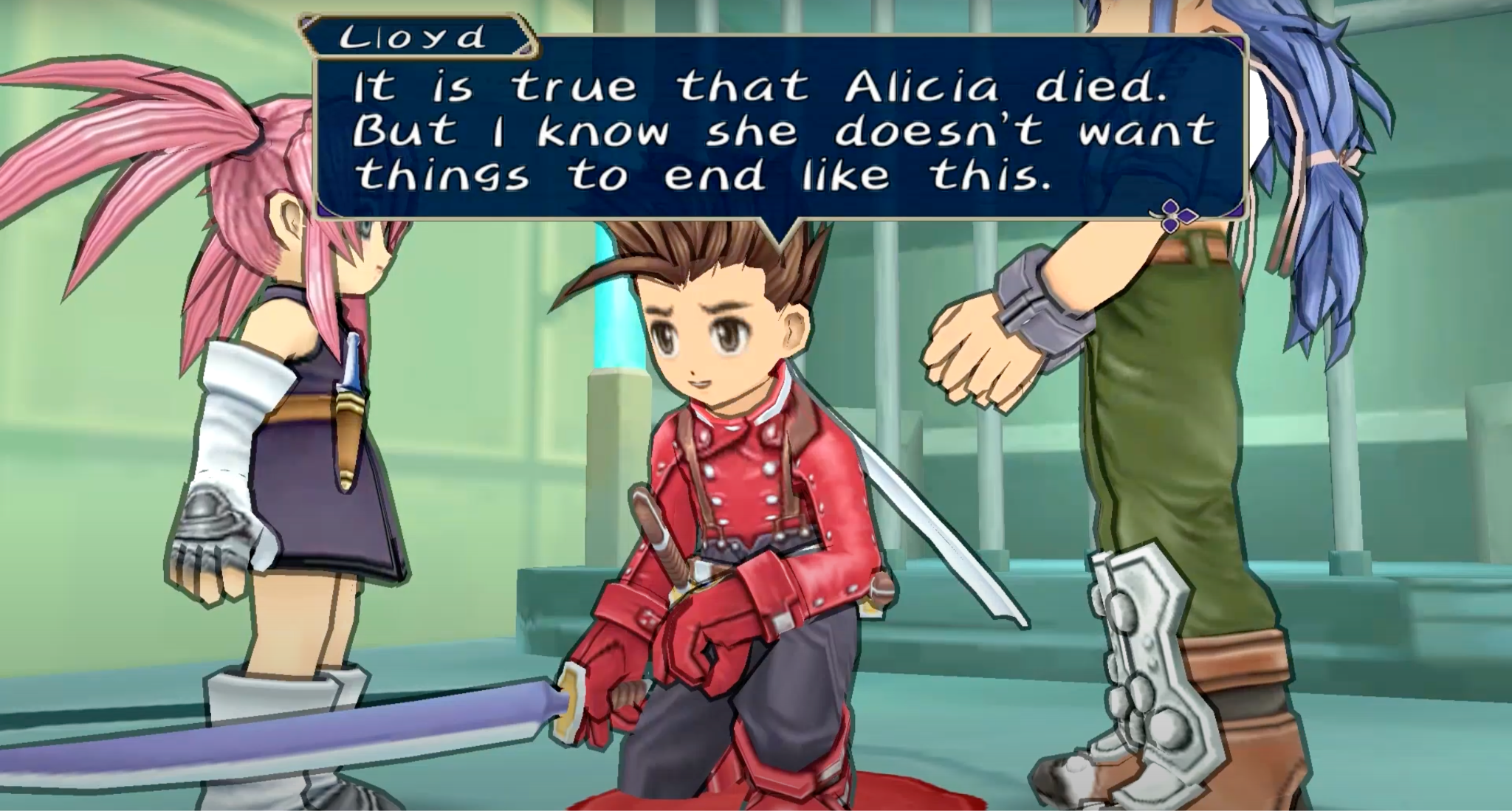
Lloyd’s perspective on the meaning of Alicia’s death brings Presea and Regal back from the edge of self-erasure in the prison of Mithos’ illusion.
The availability of other examples and other interpretations—like Lloyd’s suggestion about his mother’s perspective, “I don’t know if the decisions you or my dad made were correct, but I don’t think my mom would have wanted my dad to punish himself and live the way you have”—make it possible for Regal to avoid the solipsism that encompasses Mithos’ character, allowing him to hear Alicia when she affirms that she, too, doesn’t want Regal to live like that. This affirmation doesn’t absolve Regal of his sins, nor does it free him of blameworthiness for Alicia’s death: the reconfiguration of his shackles’ symbolism, from a form of punishment to a sign of his resolve to change the world, changes Regal’s relationship with his past from an enervating force, one which restricts his future actions and limits his identity to his need for revenge, to a motive force, one which provides him with a way to situate his revenge within a broader life narrative that reaches beyond his past.
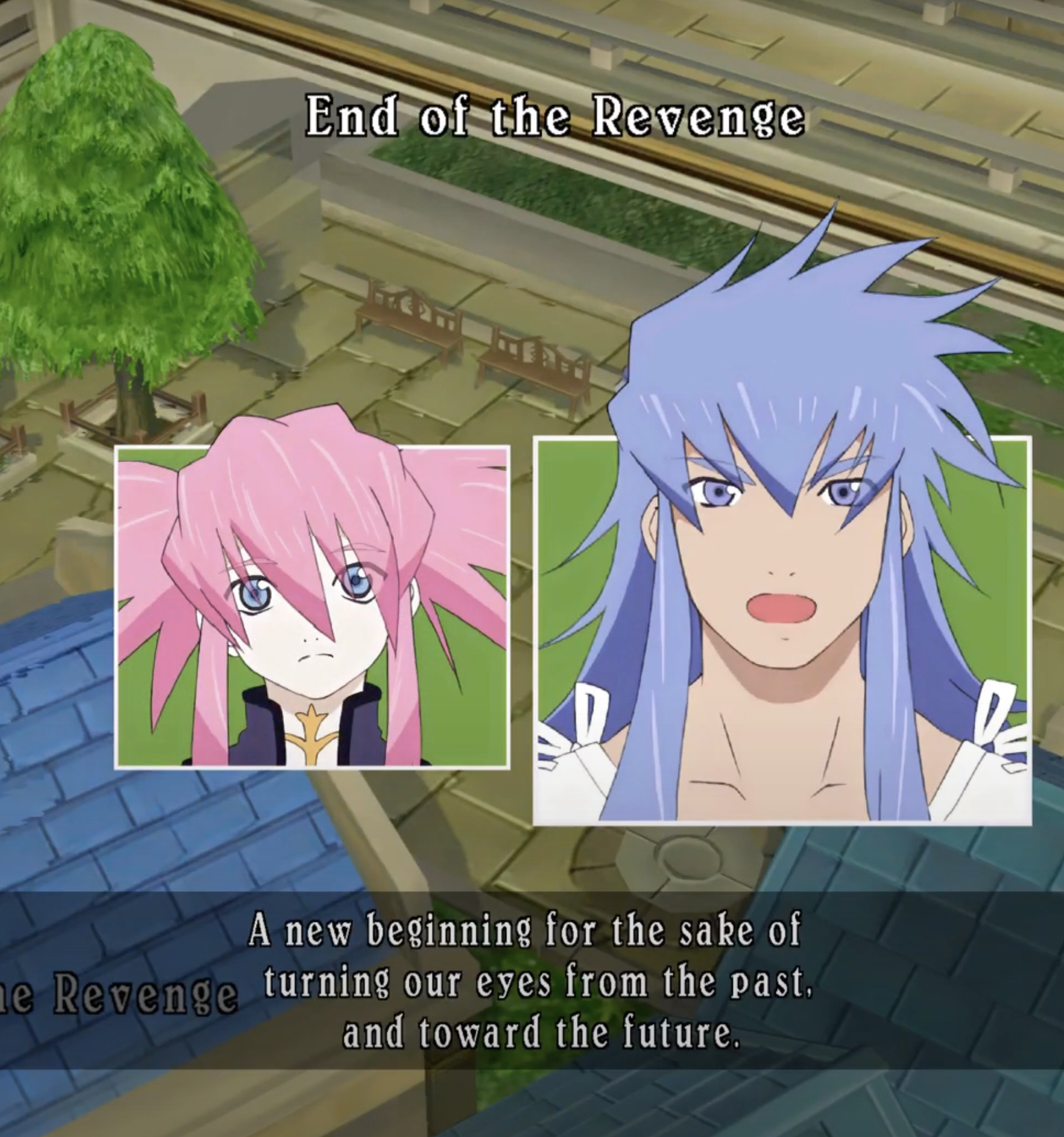
Regal and Presea reflect on, and quickly move beyond, the death of Vharley as an end to the revenge required for the death of Alicia.
The support of a party with whom to share interrelated stories of suffering and redemption allows Regal and Presea to develop new concepts for the interrelated notions of ‘revenge’, ‘punishment’, and ‘forgiveness’. While it’s all too tempting to act like Mithos and treat these notions as goals to achieve for the sake of emotional satisfaction—instituting Human Ranches to punish humans for discrimination, reconstituting his sister’s body in pursuit of a cathartic, self-serving kind of forgiveness for the sins of the world and his resentment of it—it’s healthier and more productive to use these feelings about the past in order to guide one’s future actions, learning from the past without obsessively recreating it. This is the difference between the illusion of accomplishment inherent in the “goal” of World Regeneration in Mithos’ two-world framework—only perpetually passing the buck in a cycle of decline, flourishing, repentance, and redemption—and the reality of accomplishment in creating a new world, making ontological space for countless new actions with no agenda as to what may happen next or what those events may come to mean. And once we let go of the need to satisfy an agenda, revenge, punishment, and forgiveness can become elements in the telling of a more progressive and fulfilling life story.
Lloyd’s “simple-mindedness” repeatedly articulates this latter perspective to Regal and Presea, allowing them to make new sense of their lives and relationship with each other:
- He is emphatic in Derris-Kharlan after freeing Regal and Presea from their cell from Mithos’ mind-game that he doesn’t think “everything has to be forgiven.”
- After the group discovers Altessa’s role in the Angelus Project, the Combatir sisters’ fates, and the destruction of Ozette, he shares with Regal the view that “[f]orgiving or not forgiving isn’t a punishment.”
- Following the liberation of the Iselia Human Ranch, when Presea learns about Chocolat and asks Lloyd whether he would still try to make up for the death of Marble even if Chocolat never forgave him, he reflects that “[w]hether or not you’re forgiven isn’t important. It’s the effort that matters.”
Armed with these new concepts of ‘revenge’, ‘punishment’, and ‘forgiveness’, Presea doesn’t need to forgive Regal’s role in Alicia’s death for them to value each other and respect each other’s relationships with Alicia; nor does Regal need to pay some price or accept some punishment in order to rectify his act of killing Alicia. Instead, as Lloyd offers to Regal in their intimate, optional conversation in Heimdall, seeking revenge for Alicia becomes a form of expressing Regal’s bond with Alicia: “How sad you are shows how important Alicia was to you.” Attached to their past yet free from the risk of obsession with it, Regal and Presea find the death of Vharley—the Exsphere broker who led to the downfall of Alicia and so many others—more like an inspiring footnote than the final conclusion of a lifelong quest for revenge. Form mirrors content in the fact that Regal and Presea’s reflection on the death of Vharley, “The End of the Revenge,” is relegated to an optional skit, a quiet secondary thought on the way to their more immediate goal of confronting a corrupt Pope and saving his persecuted daughter, the half-elf Kate. It’s thanks to their time and reinterpretations with each other and Lloyd that Vharley’s death is the end of the revenge, not merely the next step in a ceaseless cycle of revenge: in Regal’s words, its primary function is as “[a] new beginning for the sake of turning our eyes from the past, and toward the future.” Gameplay constitutes narrative insight, too, in Regal’s aptly named EX Gem skill, “Guilt”: far from debilitating him, this understanding of his past sins enhances his ability to fight for a different kind of future, raising all of his combat attributes when he goes into battle alongside Presea.
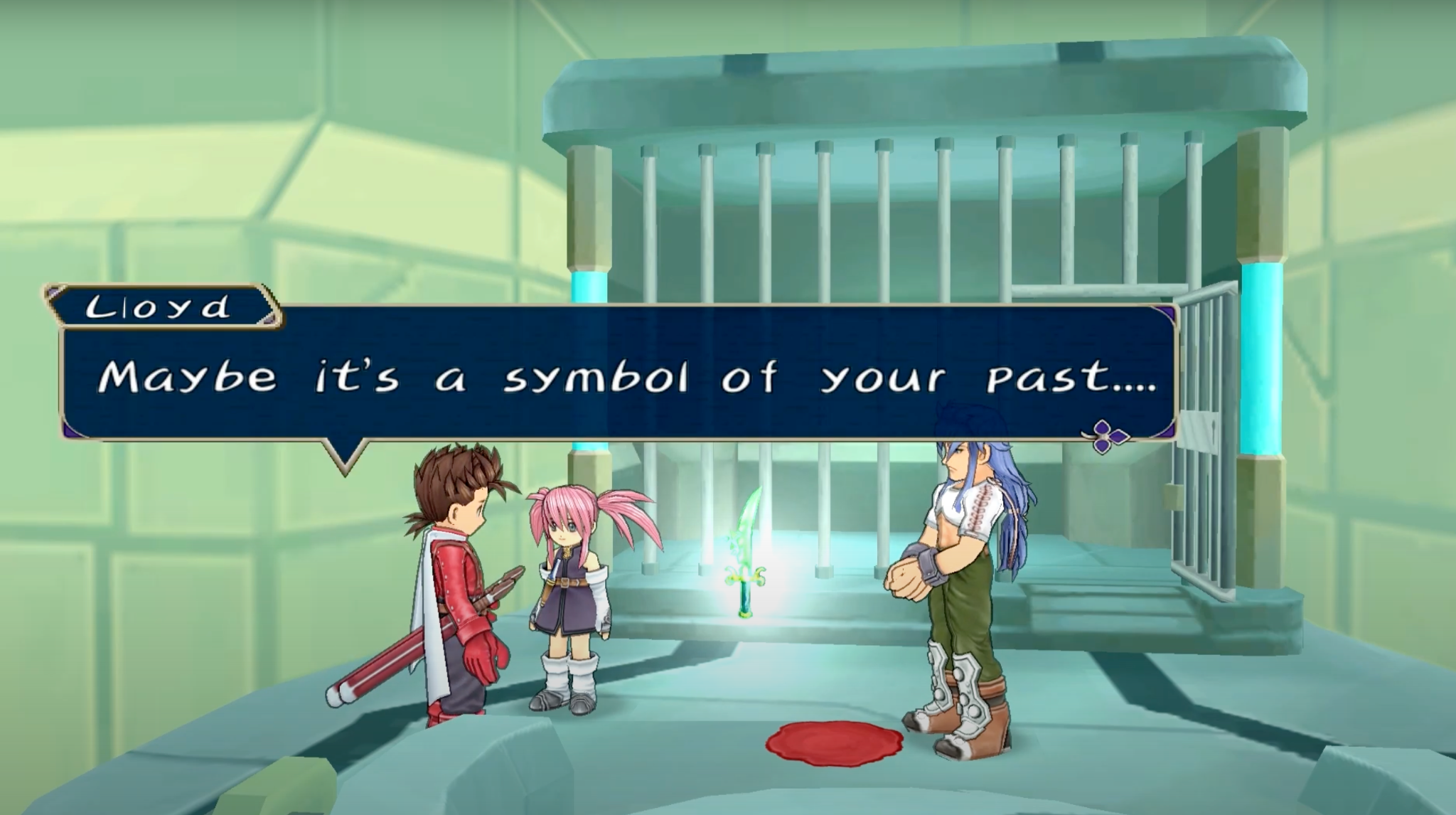
Lloyd, Regal, and Presea invent the symbolism of the Chipped Dagger after overcoming Mithos’ illusion.
The closer one looks at Tales of Symphonia, the more frequently and vividly one uncovers portraits of characters that chart their own future by actively deciding what to view as symbols in their life and how to interpret those symbols in a positive, motivational light. The provocative, prototypical case for this sort of storytelling is the triad of moments when Lloyd and his friends explicitly decide to create specific, inspiring symbols after overcoming Mithos’ final psychological torments in Welgaia: shattered glass, a spider figurine, and—in the case of Regal and Presea’s prison—a chipped dagger, the last of which they treat as a symbol of the past and an admonition not to fight amongst each other over that past. It’s this willingness to create and modify symbols that liberates Regal from his punishment without alienating him from his sin, inspiring him to leverage the same Lezareno Company resources that fueled the Exsphere crisis to travel with Lloyd and help him reshape the world for the betterment of living beings and Exspheres alike.
The pinnacle of this character development, as I see it, comes in the moment when Regal, as Lloyd’s closest friend, rejects Mithos’ attempt to possess him. When we and Lloyd are pulled into Mithos’ memories, along with Regal, to witness Mithos’ rage and horror at the murder of Martel from the perspective of that human murderer, it’s easy to imagine that scene as the kind of persecution Regal imposed upon himself after he murdered Alicia. Yet it’s also obvious by that point in the story that Regal has come to understand his penance as a positive force for change rather than as a prison of self-persecution, which is why it’s such a simple task for Regal to banish Mithos from his mind—yet also why it’s so natural for Regal to understand the sin and suffering of Mithos after seeing firsthand how similar they are.
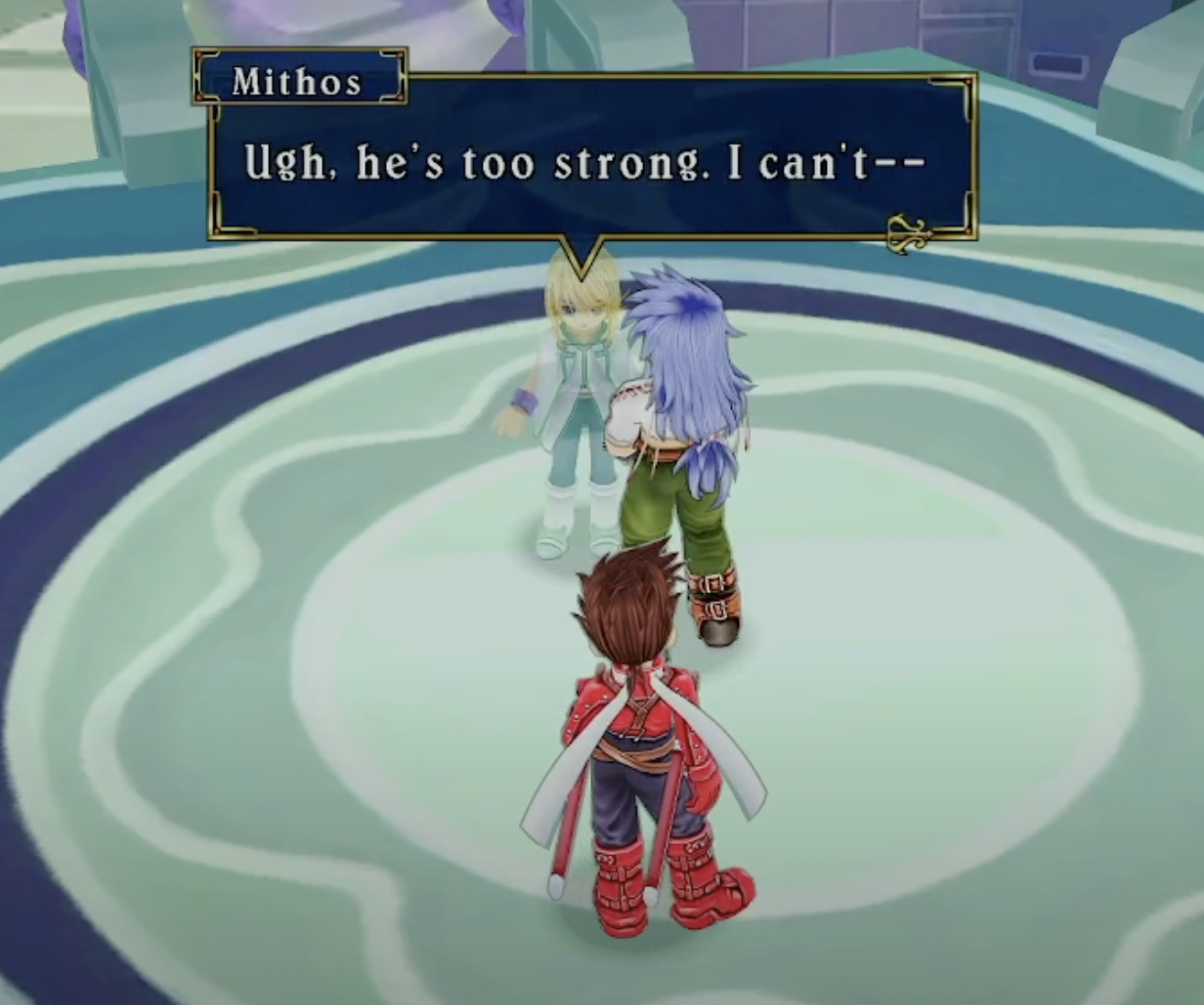
Mithos witnesses Regal’s fortitude as he fails to maintain his possessive hold on him.
Regal’s growth captures Tales of Symphonia’s message of the distinction between action and interpretation, and of the freedom we have to empower ourselves through progressive interpretations of our actions and their impacts in a world where the actions themselves often exist within causal networks over which we have comparatively little influence and direct insight. This message and character development capture the distinction between recognizing that Mithos’ actions are analogous to the party’s actions, as Regal points out during his conversation with Lloyd in Flanoir, and recognizing that this is only true “if you’re gonna put it that way,” as Lloyd says: once Regal realizes that “By putting myself in Mithos’ place [by claiming that my actions are just like Mithos’], I may have been subconsciously trying to legitimize my own justice,” he also realizes the corollary that he has the option, the prerogative, to interpret the meaning of his actions in a wide range of ways—and that realization alone empowers him to act with a freedom and redemption that Mithos cannot understand. As in the case of our actions and consequences as players throughout the game, like my accidental focus on Regal, the point isn’t to fixate on bringing about specific outcomes with absolute certainty at any cost: the point is to act and let those choices shape the world as they may, and then shape ourselves through the story we choose to tell about those actions.
How We Can Empower Kratos by Reinterpreting Him Through Regal’s Eyes
I had started my most recent playthrough of Tales of Symphonia in pursuit of Kratos, and my actions had accidentally led me to focus on Regal’s journey to process and adapt his own past actions through an optimistic gesture of reinterpretation. Why, then, shouldn’t I apply that same lesson to my own case, and use my actions in the game as a way of reinterpreting my relationship with Kratos?
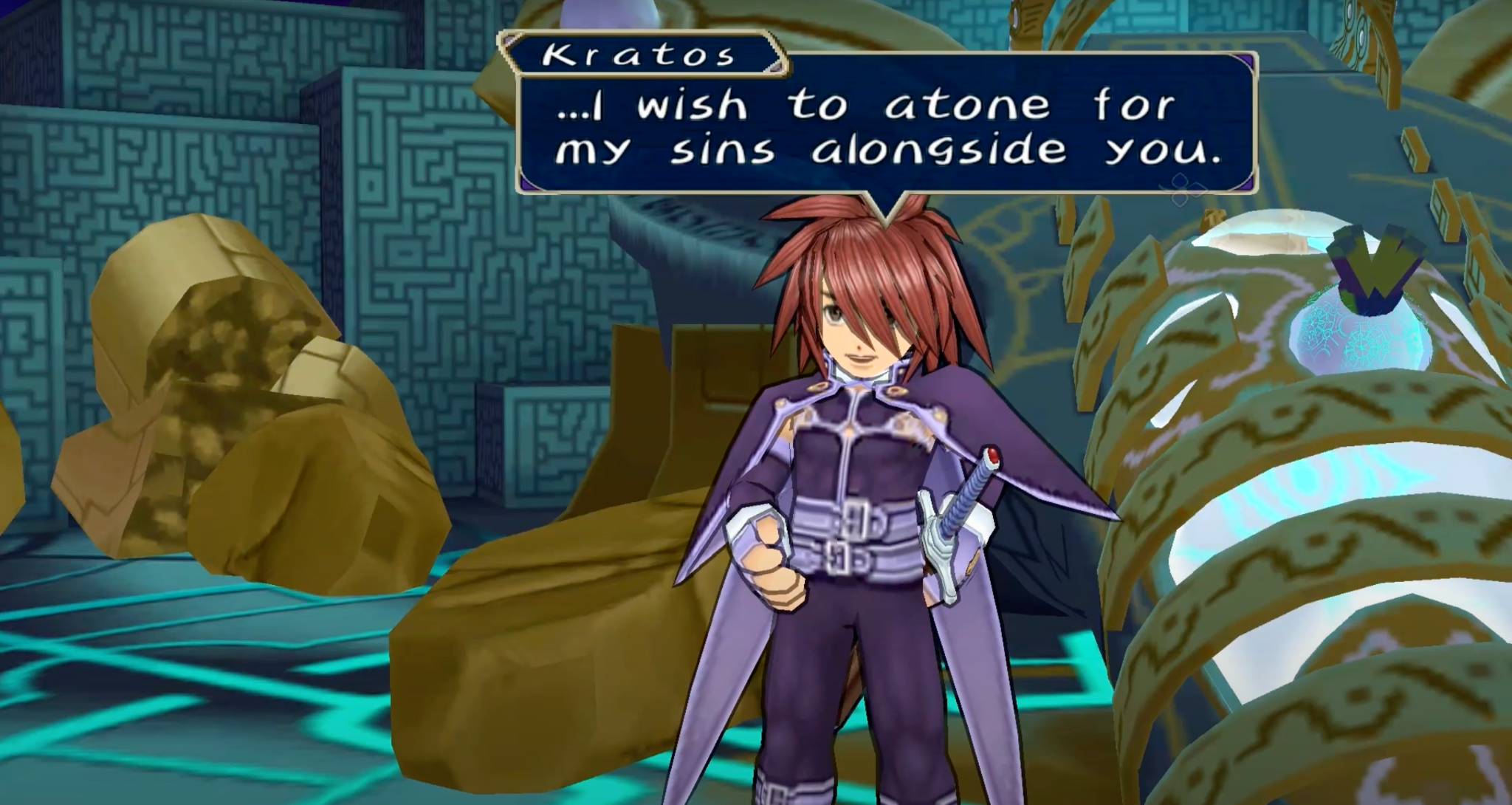
Kratos intercedes to save the party and walk alongside his son again in the fight against Yggdrasil in the Tower of Salvation.
When I turned this different kind of attention to Kratos, I began to see him in a way that was never available to me as a child: on his own terms, unmediated by Lloyd, he echoes the particular pursuit of redemption through guilt which Regal espouses. When I played through Tales of Symphonia in my younger days, Kratos’ sins—his entire past—were buried, embedded deep within the 4,000-year-old background context of the game’s story. Like many party characters throughout the Tales series (e.g., Jade, Dymlos, Judith, Lailah), Kratos’ past constitutes the static history of the world we encounter and reshape through the events in which we, as players, participate. Learning about that history over the course of the plot radically alters our understanding of the decisions the party has been making and the changes we’ve been impressing upon the world, but the history itself is a fixed set of submerged facts to be excavated: we don’t have agency to impact what happened in that past, nor even to pick up a separate game and experientially feel what it was like for the figures of that past to make, and live with, their choices (e.g., there’s no game that allows us to take Kratos, Mithos, Martel, and Yuan as our party journeying through the events of the Kharlan War).
Once I saw Regal reinterpret his own sin and redemption through his relationship with Lloyd, I took their advice in studying Kratos as a parallel to Regal: that, as Lloyd observes in Heimdall with Regal, both Regal and Kratos strike him like older brothers. In Kratos’ case, the transition from a fatherly framework to a brotherly framework invited me to treat him not merely as Lloyd’s creator and mentor in Lloyd’s own journey of heroism, but rather as someone who could dynamically learn from Lloyd by the same token that he was teaching Lloyd, in the way that idealized siblings grow up and individuate through mutual support.
- Moments like Kratos’ guidance in Lloyd’s moment of doubt and pain after learning the origin of Exspheres from Kvar transformed from a lesson for Lloyd into a quietly desperate expression of Kratos’ desire for a new vision of the future to believe in, to fight for: “ …If it were me [who had lost my life to an Exsphere], I’d want to be useful to someone with the will to break this tragic cycle. Then…perhaps I could atone for some of my sins.”
- Kratos’ remark outside the Temple of Water that he once made a “terrible” mistake, and his challenge to Lloyd following Kratos’ betrayal and their journey to Tethe’alla as Lloyd struggles with how to change the world— “If you want to do something about it, use your own head. …I thought you weren’t going to make any more mistakes?”—refocused from the esoteric guidance of a master swordsman and historical hero into a reflection of a beaten-down man who feels hollow from his submission to Mithos’ worldview and wishes to be able to imagine another way in which the world could be reshaped, though he recognizes that he’s not up to the task of imagining this new possibility on his own.
- Kratos’ exclamation of horror at the twisted germination of the Giant Kharlan Tree following the severance of the mana links between Sylvarant and Tethe’alla, followed by his somewhat cryptic decision to join Lloyd and the party in the infiltration of Iselia Human Ranch, became clarified as a turning point where Kratos perceives that quality in Lloyd which makes him different from Mithos, as he tells Lloyd in their Flanoir conversation later on: “if you make a mistake, you are capable of acknowledging it. That takes courage. Mithos, as well as I…were unable to do that.” When Kratos bears witness to Lloyd watching the worlds fall apart only to immediately suggest a novel possibility to change things for the better (“neutraliz[ing] [the Giant Kharlan Tree] by blasting it with the power of the opposing Summon Spirits”)—and when he intuits that Lloyd wants to journey to Iselia’s Ranch not only to put this plan into action, but also to rescue Chocolat, who came to hate him and deny him forgiveness for killing her grandmother for the same reason that Kratos killed Anna—he sees, for the first time in 4,000 years, a model for acknowledging failure and moving on with new, well-intentioned attempts to change things for the better, without ever letting go of one’s past sins in the process—and he sees this model in his own flesh and blood.
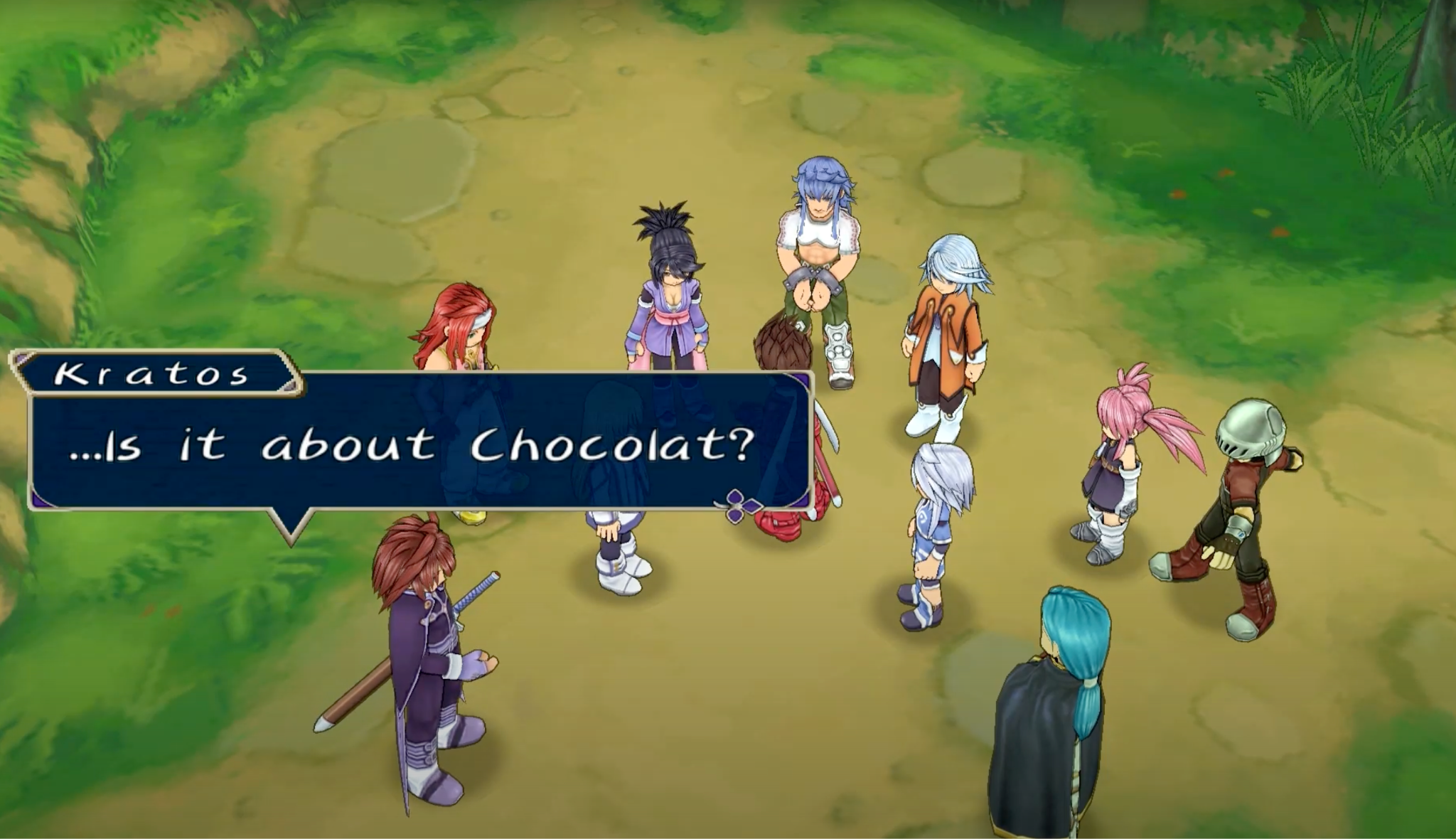
Kratos senses Lloyd’s desire to save Chocolat, couched in his plan to save the two worlds.
In one sense, Regal and Kratos are diametric opposites of each other at the beginning of Tales of Symphonia: Regal has fashioned himself into an instrument solely functioning to punish his past sins, whereas Kratos has withdrawn from any kind of utility, apathetically resigning himself to play a static role in Mithos’ world order as a shepherd of Chosens and the seal of Origin. Yet Regal’s path to empowerment and agency equip us to read the two of them as identical to each other when it comes to their way out of damnation: through Lloyd, both of these older men, imprisoned within the histories of their past journeys’ sins, experience what it feels like, and therefore how it is possible, to use the full, unadorned acknowledgment and burden of one’s past as a motive force to create a totally different future, to which that past bears no direct relation.
This process—the process of experiencing what it feels like to (1) discover the unintended consequences of one’s actions and (2) unlock the opportunity to interpret those actions and consequences in a range of ways to chart a new future—is precisely what gives Tales of Symphonia’s relationship-building system and new-game-plus structure a unique thematic role within the broader language of its storytelling. When we play through the game organically (without using a guide to shape Lloyd’s relationships exactly as we desire), we discover relationships forming around Lloyd as the opaque consequences of our own choices—I pursue a bond with Kratos, and discover a bond with Regal—but, as Lloyd does, we retain the option to make meaning out of those consequences in a wide range of ways. While the trajectories of relationships aren’t transparent to us, they’re also not fatalistic: crucially, it’s not one, but three companions who consider visiting with Lloyd in Flanoir, giving us the optionality to choose how to prioritize Lloyd’s available bonds, in much the same way, for instance, that Regal chooses how to prioritize his relationships with Presea and Alicia over his fixation on punishing himself.
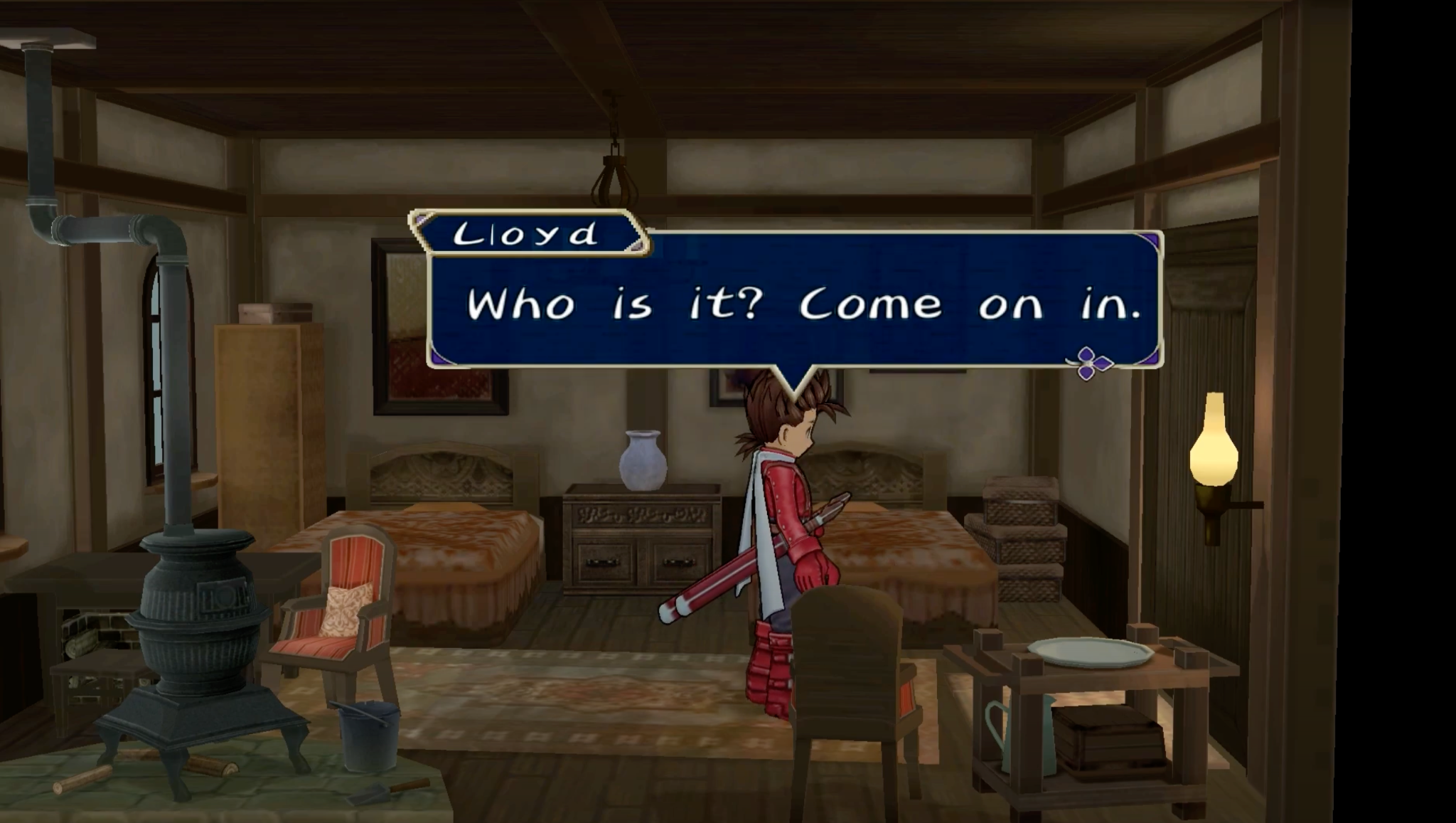
The pregnant moment in Flanoir before one of Lloyd’s closest friends asks if he’d like to go outside and see the snow.
The game’s new-game-plus structure encourages us to take our previous set of relationships as a new starting point for interpreting the story and our available actions in new ways, inviting reinterpretation of past events (the actions of our previous playthrough) rather than an alternative set of events and interpretations (as would be the case in a game that only allows you to start a new game, beginning afresh rather than continuing the same story of your overall experience as a player with Tales of Symphonia by stringing a further playthrough onto your previous one, as one writes a new chapter to continue one single novel). It’s all the more fitting in this regard that the game’s Grade Shop, which allows you to choose which elements of your previous playthrough to carry over to your next playthrough, explicitly gives you an affordable option to carry Lloyd’s current interpersonal relationships over into the next game, forcing a conscious decision about the relationship you want your next set of actions and relationships in the game to have with your previous set of actions and relationships.
It’s on account of this narrative structure that (1) a playthrough focused on Kratos after discovering Regal as an adult and (2) a playthrough discovering Kratos without previous context as a child bear radically different meanings, even if the player were to make all of the same choices within both of those Kratos-focused playthroughs. It’s also on account of this structure that the player of Tales of Symphonia learns how to more directly influence the perspectives and future outcomes of those other than themselves through the power of optimistic interpretation—both in the real world and in the game’s successor, Tales of Symphonia: Dawn of the New World.
Creating New Worlds through Active Interpretation
At first glance, Dawn of the New World seems to diverge in a range of broad and deep ways from its predecessor, leaving many—including me, the first time I played it—to wonder how it really qualified as an extension of the story Tales of Symphonia wanted its player to experience. Yet many of these divergences relate to the first game in ways that challenge its core themes, and challenge the player’s understanding into the bargain.
The Vanguard’s invocation of the Sylvarant Dynasty as a right to rule puts exactly this kind of pressure on our understanding of the relationships between actions, consequences, and interpretations. Superficially, these villains are doing the same thing Tales of Symphonia taught its players and characters to do: they’re surveying their history in the world, the sequence of events that brought them to their current state of persecution, and drawing a newfound sense of agency from an interpretation of that history as the Church of Martel’s oppression of the rightful royal lineage of Sylvarant, thereby justifying their insurgent efforts against the Church—and, by extension, Tethe’alla—and their directive to unify Sylvaranti under a singular, nationalistic regime. Yet their interpretation is founded on the same kind of toxic self-justification that Mithos used to shut others out and resist any modifications of his course in the world: they empower themselves at the cost of others and thereby trap themselves in their perspective on the past, becoming their own obstacle to collaborating with others for a different, more mutually productive future—all for the sake of a kingdom with virtually no trace and no role in the trajectory of civilization for the past 800 years, and which therefore, as Marta insists before her father, “has no bearing on who we are right now.”
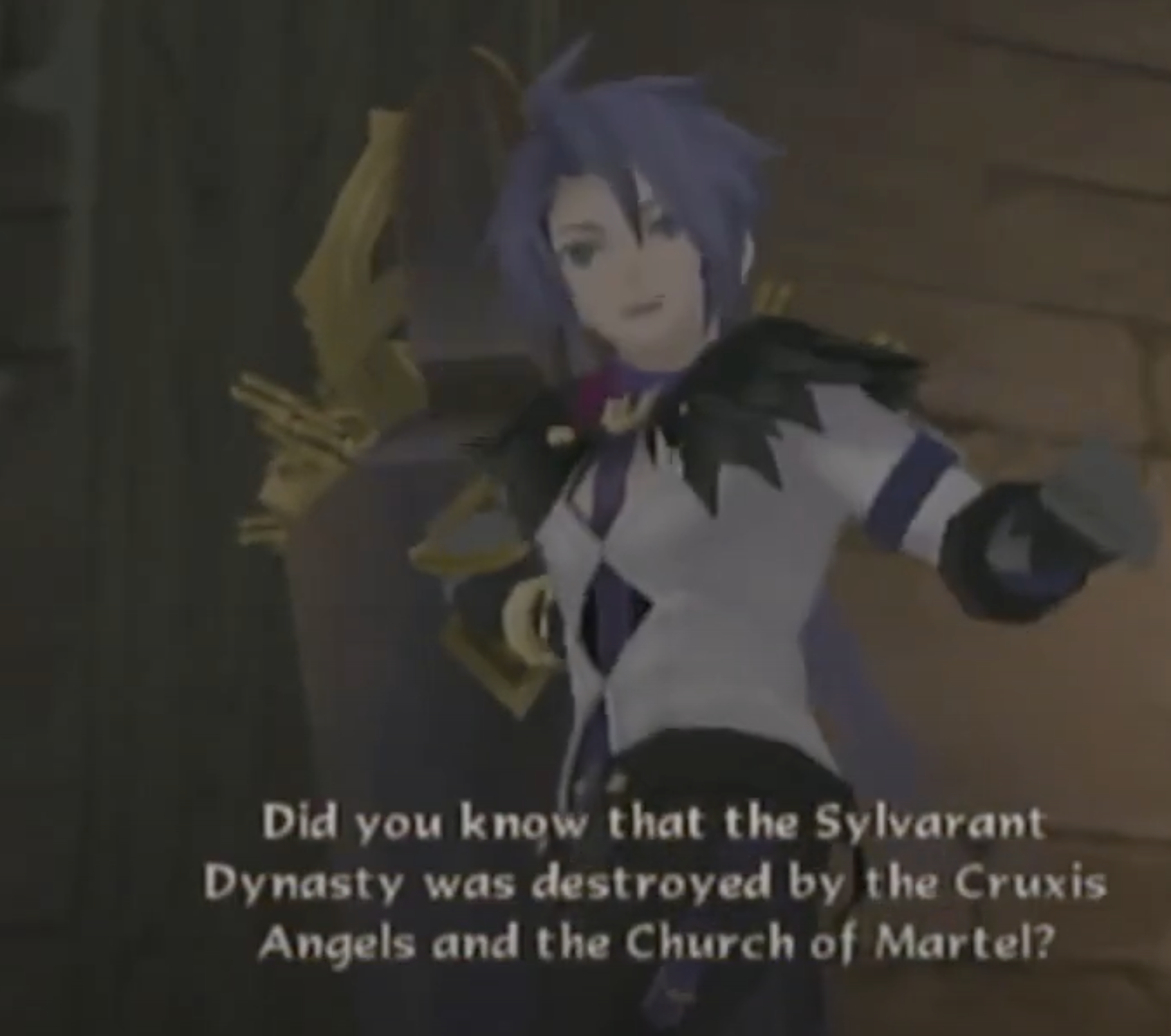
Decus offers the erasure of the Sylvarant Dynasty by the Church of Martel as justification for the Vanguard’s agenda.
It’s illuminating on this interpretation that Regal centrally features as the Vanguard’s hostage in their plot to resurrect the Sylvarant Dynasty and overthrow the seats of Tethe’allan civilization, including Regal’s home of Altamira. Far from Regal’s self-imposed prison sentence of self-punishment in Tales of Symphonia, the Regal of Dawn of the New World uses literal imprisonment and his guilt over the sins of Tethe’alla and his own company to help safeguard the well-being of the new world for everyone: donning specially made handcuffs as subterfuge to disrupt the Vanguard occupation of Altamira and save its citizens, and becoming the Vanguard’s prisoner in order to secure the escape of his friends. In the myopic worldview of the Vanguard, Regal is a symbol of Tethe’alla, a Duke and the leader of a globally influential Tetha’allan corporation; yet Regal learned long ago how to turn the sins of these titles into the motives for a better future, and it’s this commitment to the free trajectory of a united world that makes possible the party’s defeat of Brute in their rescue mission to save Regal, inadvertently liberating the leader of the Vanguard from the corrupting influence of Solum’s core (with some help from Decus) and opening his mind in a more literal analogue to the way Regal has slaved to empower everyone to better see and support each other.
Tales of Symphonia: Dawn of the New World puts Regal, the player, and the rest of the original Tales of Symphonia party in a new position: despite the fact that they didn’t always know how their actions could impact their world, their actions shaped the world in central ways, and they’ve now become historical figures, not unlike Kratos and Mithos in the first game. A consequence is that these characters all have an onus not merely to interpret their actions in ways that empower themselves, but also in ways that positively motivate the world—the antithesis of the Vanguard’s approach to world history. In place of the surprise and discovery we experienced uncovering the impacts of our choices on character relationships in Tales of Symphonia, we have the responsibility to choose what interpretation of those events, of our own previous choices, will best contribute to the stories of those who struggle to find a way to live in this singular, new world that allows everyone to act as agents in communal contexts. We have the option to “decide” in Dawn of the New World who became Lloyd’s closest relationship in Tales of Symphonia, with no encoded guarantee that this closest relationship will be the same as the particular outcome of one of our personal Tales of Symphonia playthroughs (i.e. there’s no system that takes your Tales of Symphonia game as an input and forces the same party relationships to present themselves in Dawn of the New World). This might seem as though it introduces a lack of continuity between the first and second game, and of course it does—but the progression from Tales of Symphonia to Dawn of the New World teaches us that continuity of events isn’t what matters. Fixation on the specific events of our lives, or of the world’s history, locks us into a network of causal relations over which we have little control and which do little to actually illuminate our understanding of our place in the world: what matters is the story we tell from those events, a far more malleable and informative matter than the literal substance of uninterpreted actions.
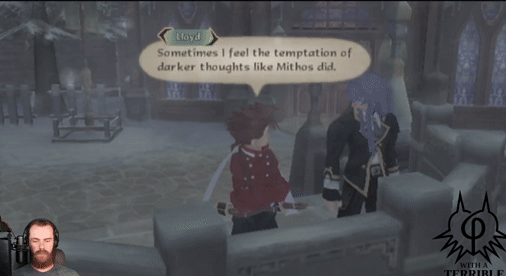
Regal helps Lloyd to make a positive motive force out of his sympathies with Mithos, in a mirror to the help Lloyd offered Regal in interpreting his quest for revenge in Heimdall.
I chose to make Regal Lloyd’s closest relationship in Dawn of the New World not primarily for continuity with my Tales of Symphonia playthrough, but rather because Regal had presented himself as the cipher to understanding how to honor one’s past without becoming a slave to it—both in liberating himself as a person, and in liberating the Sylveranti from the yoke of the Vanguard. Through my choices, I told a story about his role in the maturation of Lloyd and the illumination of Kratos’ redemption in much the same way that I’ve told a story in this analysis—and in much the same way that Lloyd tells Emil a story of Mithos, transforming a bitter and resigned tyrant into a fallen friend who breathed life into the World Tree supporting those possibilities of which he refused to avail himself.
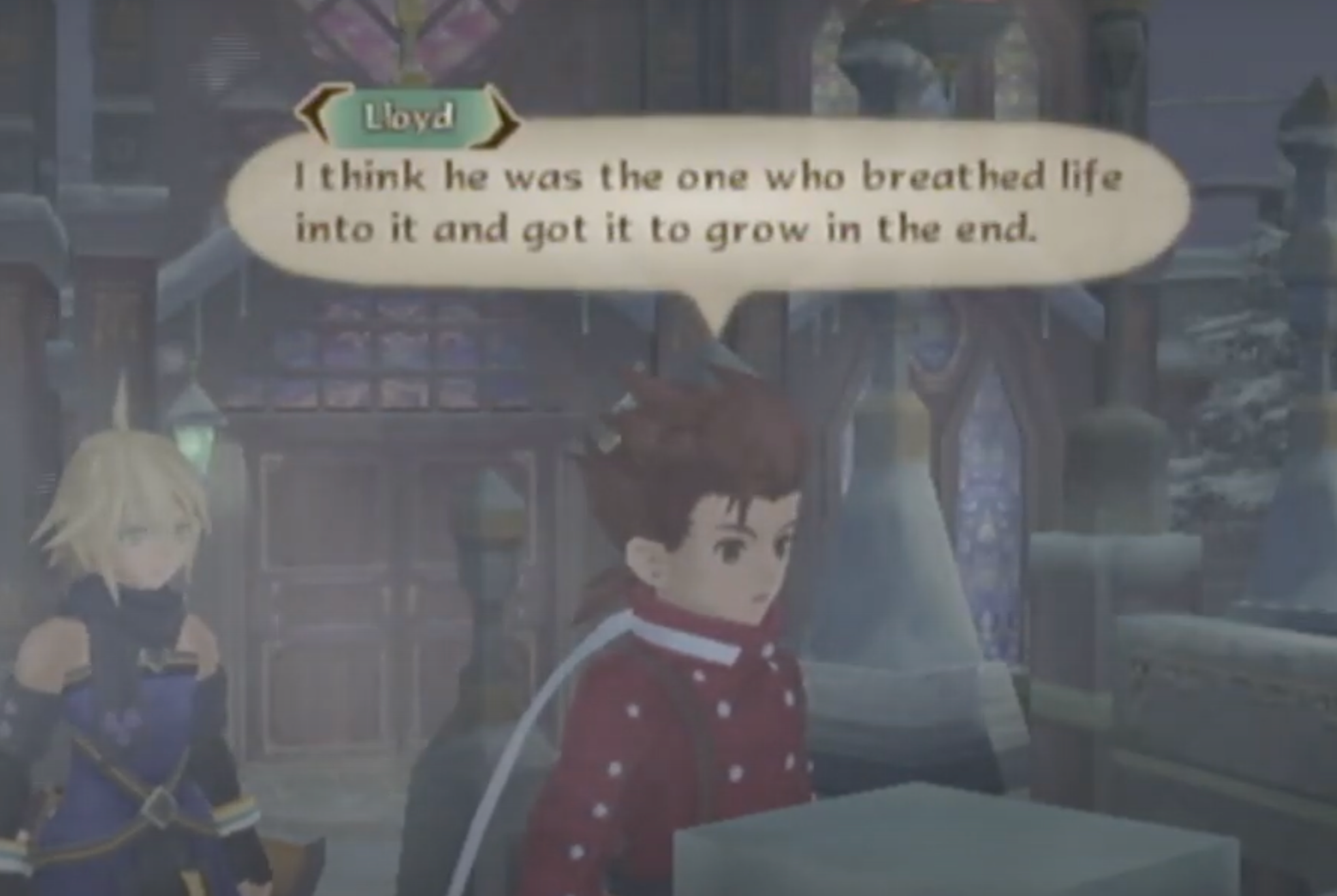
Lloyd recasts Mithos as a friend whose will was essential in germinating the new World Tree and reuniting Sylvarant with Tethe’alla.
The climax of what Regal taught me is the climax of Tales of Symphonia: Dawn of the New World. We can only act as healthy agents in the world by consciously, willfully embracing an interpretation that lets our past chart a future beyond our sins without divorcing ourselves from those sins; we can only make such interpretive options possible for others by offering a framework for understanding the world as an ecosystem whose history is similarly influential yet non-binding. But for the people around us to actually seize those options, we can’t just passively tell stories interpreting past events: we must turn interpretation into an action in the present tense, telling stories about others that inspire them to see and treat themselves as agents. The difference between which aspect of our avatar’s heart wins out—between our avatar acting as the Summon Spirit Ratatosk who would exterminate humanity or as the human Emil who would love and find harmony with all life—consists only in how we, as players, act in interpreting him at the conclusion in the Ginnungagap. Through the gameplay of the final battle, we must act in such a way as to interpret him as someone who would not betray his friends—in effect, we must trust his humanity—in order to create the reality of a story, an outcome of the world, in which Emil can live a human life and Ratatosk can embody the meaning of his namesake: relaying messages and intentions throughout the entire ecosystem of beings situated throughout the new World Tree, and weaning the world off of mana in order to rectify the natural order of the universe, empowering each human to legislate herself without dependence on a foreign animus.
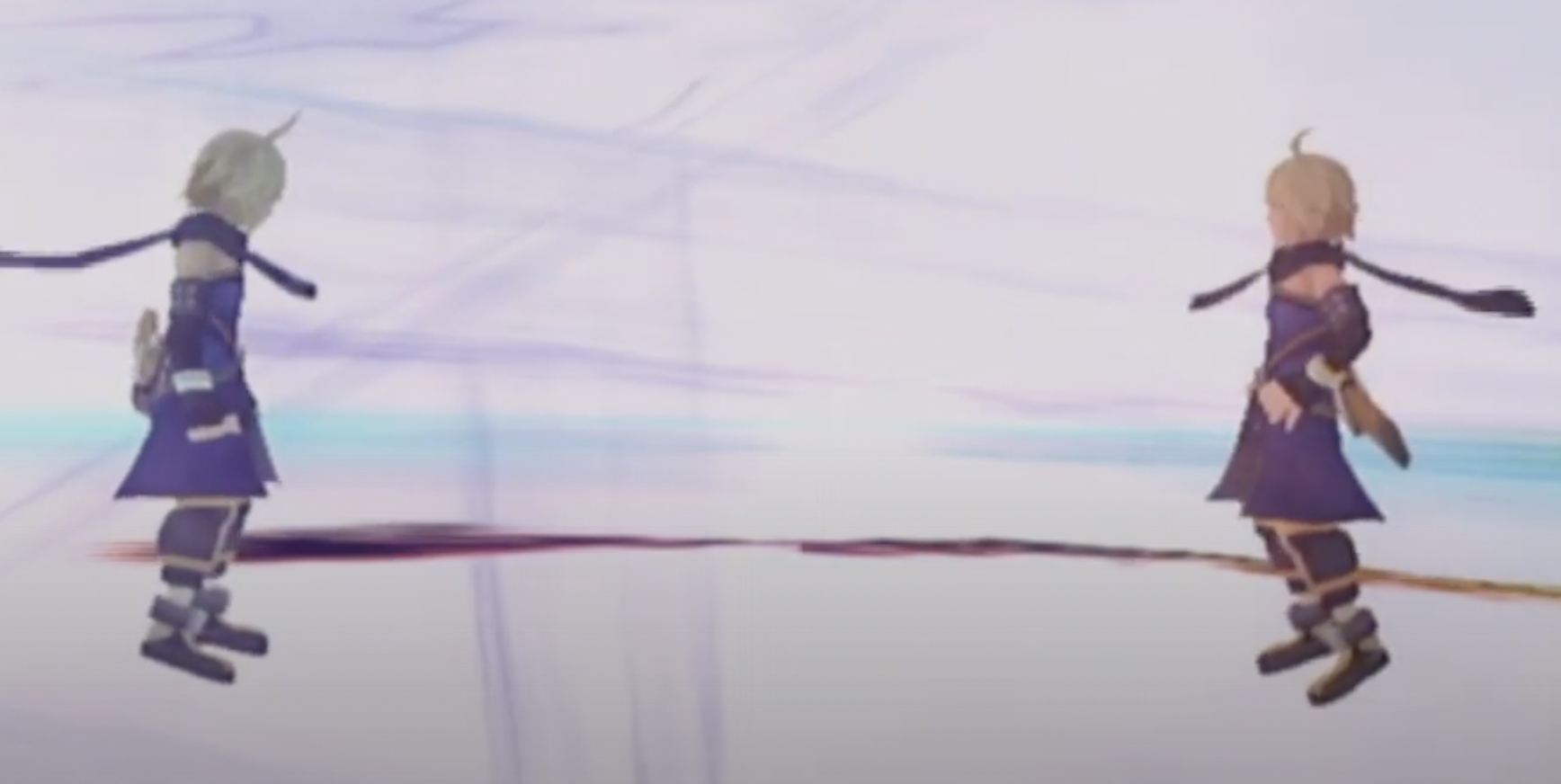
Emil and Ratatosk adjudicate the two faces of their identity in a way that’s only possible because of the grace and interpretive understanding which characters like Regal, along with the player, have afforded him over the course of his journey.
On a journey through two games and four worlds, my time with Regal taught me how to undergo his simple yet superhuman metamorphosis: to release yourself from your past by owning your past; to discover others by integrating them into your past; to give others a future by trusting them to find one on their own.
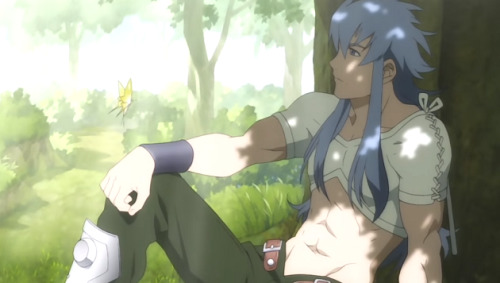
- It’s true that, on the level of the game’s technical systems, each positive interaction with Regal accrues more positive valence to his relationship with Lloyd than any single positive interaction with an earlier-introduced character accrues between Lloyd and that character. From a thematic perspective, though, on the assumption that the player won’t make a point of engaging with 100% of the game content purely for the sake of completionism (i.e. pursuing the position of having completed all content in the game purely for the sake of having completed as much as possible in a single playthrough), it remains proportionately less likely that a player with antecedent connections to, and investments in, established characters in the party would elect to disproportionately invest her attention in a new character at a relatively late stage in the game’s story. ↑
- This is certainly not meant to disparage this resource: like all “text dumps” or “full scripts” of video games, this is an invaluable tool in easily navigating the entire story of a game in a searchable fashion and uncovering connections you may never have noticed otherwise. My sincere thanks to Oliver Kong for making the effort to create such a high-fidelity, comprehensive companion reader for Tales of Symphonia. ↑
- I count Sylvarant, Tethe’alla, and Derris-Kharlan as the game’s three worlds. ↑
- It’s interesting to consider how much of this change in my approach to the party has to do with growing up and being drawn toward characters with different kinds of histories, and how much of it has to do with becoming “literate” in video-game stories over the course of the roughly two decades between my first Tales of Symphonia playthrough and my most recent one. Tales of Symphonia was one of the very first video-game stories I ever experienced, and when one is a newcomer to the medium, I think it’s intuitive to seek out one “main character” to treat as your representative and sole focus in exploring the world, even if that’s not how video-game stories really work. It may require a certain amount of exposure to the breadth and depth of video-game stories before a player can explore and invest in an entire JRPG party in an even-handed manner, since this kind of communal point-of-view cuts against the grain of how some of us intuit our relationship between ourselves, avatars, and the worlds of video games. In all likelihood, then, I suppose the best explanation of my shift in focus in the case of Tales of Symphonia comes partly from “growing up” in the sense of related to older, more experienced characters, and partly from “growing up” in the sense of acquiring more facility with the language of video-game storytelling. ↑



